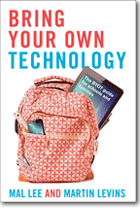Bring Your Own TechnologyThe BYOT guide for schools and families
|

|
 Diese Seite wurde seit 11 Jahren inhaltlich nicht mehr aktualisiert.
Unter Umständen ist sie nicht mehr aktuell.
Diese Seite wurde seit 11 Jahren inhaltlich nicht mehr aktualisiert.
Unter Umständen ist sie nicht mehr aktuell.
 Zusammenfassungen
Zusammenfassungen
 This ebook is designed to provide teachers and parents alike an insight into the bring-your-own-technology (BYOT) revolution sweeping across entire school communities in Australia, the US and UK, and explain the immense implications of these developments.
This ebook is designed to provide teachers and parents alike an insight into the bring-your-own-technology (BYOT) revolution sweeping across entire school communities in Australia, the US and UK, and explain the immense implications of these developments.
In time all schools in the developed world will move to students using their personal mobile technology in class, rather than it being provided by the school. It is not a case of if, but when. BYOT is like a tsunami coming across the horizon. The forces impelling the change and the potential educational, social development, economic, technological and political opportunities opened by the development will not only bring about its introduction but will soon fundamentally change the nature of schooling, teaching, the technology used, home-school relations and the resourcing of schools.
The potential implications of the development are immense. BYOT is far more than a technical change. However its full potential will only be realised by schools, their leadership and their communities collaborating astutely to achieve the normalised 100% student use of the technology. That challenge will be considerable. This ebook, drawing on the work of the pathfinding schools and education authorities in the UK, US and Australia, is designed to provide teachers and parents alike an insight into:
- Why the development needs to be embraced
- The imperative of authentic collaboration between home and school
- What each school needs to do to ready itself
- How to deal with the raft of options
- The kind of whole school community implementation strategy required
- The practicalities of achieving sustained total student usage and the many dividends that will then flow.
 Dieses Buch erwähnt ...
Dieses Buch erwähnt ...
 Begriffe KB IB clear | BYODbring your own device
,  Eltern Eltern parents
, parents
,  LehrerIn LehrerIn teacher
, teacher
,  Schule Schule school
, school
,  USA USA
|
 Dieses Buch erwähnt vermutlich nicht ...
Dieses Buch erwähnt vermutlich nicht ... 
 Nicht erwähnte Begriffe | Bildung, Digitalisierung, Kinder, Lernen, Schweiz, Unterricht |
 Tagcloud
Tagcloud
 Zitationsgraph
Zitationsgraph
 Zitationsgraph (Beta-Test mit vis.js)
Zitationsgraph (Beta-Test mit vis.js)
 2 Erwähnungen
2 Erwähnungen 
- BYOD in Schools Literature Review 2013 (2013)


- Bring your own device (BYOD) in der Volksschule - Masterarbeit im MAS Social Informatics (Armin Lüchinger) (2014)

- Bring your own device (BYOD) in der Volksschule - Leitfaden für die Umsetzung (Version 2.0) (2014)


- Bring your own device (BYOD) in der Volksschule - Leitfaden für die Umsetzung (Version 2.0) (2014)
 Volltext dieses Dokuments
Volltext dieses Dokuments
 Bibliographisches
Bibliographisches 
 Beat und dieses Buch
Beat und dieses Buch
Beat hat dieses Buch während seiner Zeit am Institut für Medien und Schule (IMS) ins Biblionetz aufgenommen. Beat besitzt kein physisches, aber ein digitales Exemplar. (das er aber aus Urheberrechtsgründen nicht einfach weitergeben darf). Aufgrund der wenigen Einträge im Biblionetz scheint er es nicht wirklich gelesen zu haben. Es gibt bisher auch nur wenige Objekte im Biblionetz, die dieses Werk zitieren.













 Biblionetz-History
Biblionetz-History